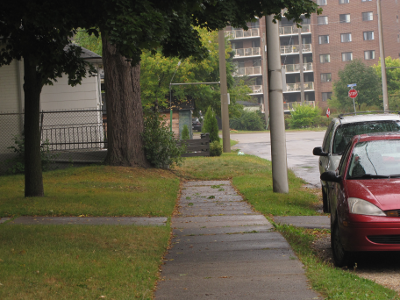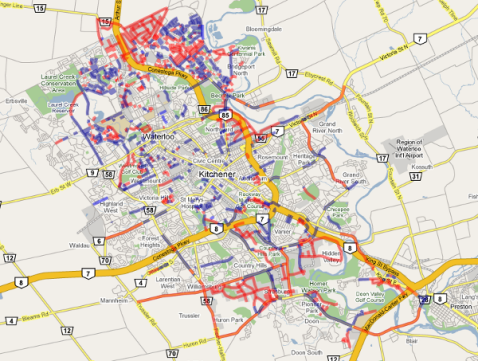Missing sidewalks in Kitchener-Waterloo

For a city to be open to pedestrians, there need to be paths between useful destinations, the paths need to be maintained, and pedestrians need to feel safe. Before you can run, you have to walk, and before you can walk, you need a place to do it. In Kitchener-Waterloo there are numerous roads that are missing sidewalks, often on both sides of the street. Sometimes the sidewalks are sporadic: they appear and disappear on a stretch of road. Occasionally one-sided sidewalks even switch sides at intersections. Suburban subdivisions are haphazard, sometimes having full sidewalk coverage, but just as often leaving them out. And sidewalks in industrial areas are simple: there just aren’t any.
I set out to document the state of missing sidewalks in Kitchener and Waterloo. Using Google Maps, I drew red lines for roads missing sidewalks on both sides and blue lines for those missing a sidewalk on just one. I tried to cover everything that is not a suburban subdivision, and I did Eastbridge as an example of a suburban area. There are undoubtedly missing sidewalks that I did not document, and probably some tiny sidewalks that I mistook for curbs. Click on the below map image to see it on Google Maps in more detail. [Update: This is based on 2006 satellite imagery, and a few sidewalks have been put in since then.]
The list of important roads with serious sidewalk absences reads like a who’s who of roads in the region: Fischer-Hallman Rd, Fairway Rd, University Ave, Westmount Rd, Seagram Dr, Victoria St, Homer Watson Blvd, Bleams Rd, Manitou Dr, Lackner Blvd, Bridge St, Northfield Dr, and even King St and Weber St by the St. Jacobs Market. The suburbs are missing many useful sidewalks. And the north Waterloo and south Kitchener industrial parks — while currently devoid of sidewalks — would be quite reasonable places for them, as both are within walking and biking distance of residential areas and transit hubs.
Of course, it isn’t enough for sidewalks to exist. The sidewalks need to be maintained, cleared of snow in the winter, free of standing water, and so on. There need to be walkway connections. There need to be places to walk to. However, sidewalks are a significant step, as they invite people to consider their use and have symbolic value as a commitment by the municipality to its pedestrians.
By the Region of Waterloo’s own estimates, it would cost less than $20 million to add in all the missing sidewalks on regional roads. I would guess it would cost less than $100 million to construct every single missing sidewalk in Kitchener-Waterloo. Considering the region and the two cities can afford to spend around $100 million a year on roads, we can afford this.
What would be the outcome if we added in all the sidewalks? First of all, the people who already walk in these places would now be able to do so safely. Other people will consider walking when they otherwise wouldn’t have risked the side of the road. Many probably aren’t currently willing to walk because there literally is no space for it, or because they are afraid that poor weather would make their journey back unpleasant. Perhaps most intriguingly, there are many missing sidewalks along fast-moving roads to destinations that may be far for walking, but just right for cycling. I think a secondary outcome would be that many will consider cycling on low-population sidewalks as an alternative way to get to their workplace from their suburban homes — both of which may now be solely accessible by car. I know that legally bicycles are supposed to be on the roads, but as a practical matter, many roads — especially in suburban areas — tend to be scary for prospective cyclists, and consequently a very strong deterrent if they are missing sidewalks.
I don’t think sidewalks are always necessary on both sides of the street, particularly if one side does not have any connections. However, calculations about where sidewalks may or may not be needed must be viewed with suspicion, as they appear to me to be prescriptive rather than descriptive. The purpose of sidewalks and walkways should not be just to provide a choice for people, but also to accommodate the choices that will be made and already are being made by pedestrians. People in industrial areas do walk, as do people in the suburbs, whether or not planners think it reasonable. If you look carefully at the satellite imagery in the above map, you will find many places with footpaths in lieu of missing sidewalks.
There is a possibility that if you build a sidewalk, it will not have a use. For 60 years we have been erring on the side of building fewer sidewalks than necessary. It’s about time we started building at least as many sidewalks as we need, and perhaps a few more. Widen (and create) sidewalks, not roads!
12 responses to “Missing sidewalks in Kitchener-Waterloo”
Trackbacks / Pingbacks
- - April 19, 2010


You state that it’s based on imagery (or info) up to 9/21/2009.
Northland Road has had a sidewalk on the south side going east from King for approx 500m since last year.
Your map doesn’t show this and neither does Google imagery. That would lead me to think that there are probably a few other places in the city in a similar situation.
I’d double check on your images/info source.
good luck!
Thanks for the response. Unfortunately the Google Maps imagery is a full three years old, so I’m sure there are a number of such places. I’ll probably have to be content with keeping this map a snapshot of the 2006 state of sidewalks, which is still mostly accurate.
A very interesting project. There are a couple of spots in my neighbourhood where the sidewalk disappears mysteriously, only to reappear again a single block down the road. It always baffled me, especially given how many people normally walk around there.
I’d like to point out, though, that your suggestion of sidewalks along fast-moving roads being appropriate for cyclists is currently in contravention with both Kitchener and Waterloo bylaws. Both cities have bylaws that prohibit cyclists with wheels larger than 50cm (approx 20 in) riding on the sidewalk.
Unless the cities are willing to create dedicated cycling spaces separate from motor vehicle roads, the safest spot for cyclists will always be on the road, moving with the rest of the traffic.
Thanks for the reply. I honestly don’t have a strong position on whether bicycles should or shouldn’t be on the road. However, my impression is that the vast majority of people won’t ever consider cycling on fast-moving arterial roads, bicycle lanes or not. In these sorts of places being able to ride on the sidewalk would be a serious increase in non-car mobility. Especially when we’re talking about places with low pedestrian traffic, I personally would rather see a bicycle on the sidewalk (being ridden carefully and courteously!) instead of a car on the road. I hope the Region continues to think the same way.
As someone who commutes on foot an hour a day, I do have a strong position on whether bicycles ought to be allowed on sidewalks, and I support the K-W bylaws that prohibit sidewalk cycling. Cyclists who have a fear of using arterial roads — and that fear is perfectly justified — should use less busy routes. It is unreasonable to want to turn a cyclist’s problem (fear of mixing with fast-moving traffic on the street) into a pedestrian’s problem (fear of encountering a fast-moving cyclist who rides with a sense of entitlement). Almost every day I encounter cyclists who evidently assume that pedestrians ought to step aside to make their passage easy. I find it objectionable to hear people argue that sidewalk cycling is preferable to driving a car when the facts remain that sidewalk cycling is illegal, driving a car is not. People who don’t like the law that prohibits sidewalk cycling should be working to change it. Finally, Michael’s use of the phrase “low pedestrian traffic” is somewhat irresponsible, since what is low in his view may not be low in someone else’s.
For what it’s worth, the rebuilt Fischer-Hallman has continuous sidewalks on both sides from Erb to Columbia.
Incidentally, this might be verified using Street View, as the Street View pictures are much newer. Doing that for all streets is likely an unduly high amount of effort, though.
You’re right — now that I think about it, I’ve even biked on the new sidewalk (Fischer-Hallman is scary). But yeah, I think this isn’t the right way to be tracking progress over time. Ideally something like that could be a layer on some open maps, with the information possibly crowdsourced and updated as changes are considered or made; might be a project for TriTAG.
One of the Region’s plans when it comes to arterials is to make bike-useful sidewalks – this means an asphalt trailway instead of the usual sectioned concrete.
An excellent example of this is the east side of Fischer-Hallman in the new section north of Erb. The wider, asphalt path is designed for bikes and pedestrians (and inline skaters and skateboarders…).
Thanks for the comment – I hadn’t thought about that being an overall strategy. It’s definitely a good way of accommodating real-world behaviour on arterial roads and I’m glad to hear they’re doing it. I do know that the staff proposal for the Franklin Boulevard redesign (alas, not up to the 401) calls for such paths on both sides.
This is great! I will post it as a link on my blog. In the next few weeks, Regional staff will be coming with a plan for cycling and sidewalks so I will be well armed!
I live on McDougall which runs between Erb st. and Keats Way south of the university and it has no sidewalk whatsoever and is filled with massive potholes. This causes cars to swerve towards bikes and pedestrians to avoid the potholes and can be very scary walking down. I feel like this street is an example of waterloo’s attitude towards infrastructure as a whole. It feels like im walking down a country road even though I’m supposedly in a “city”, and yet all the benefits of being in the country such as fresh air and lots of green space are absent from waterloo. Waterloo seems like it wants to have all the negative aspects of a city, such as congestion, smelly air, and ugly suburban developments mixed with commie blocks (ugly highrises built in the 50s and 60s) along with the negative aspects of a small town in the country such as bad roads, bad public transit, and a serious lack of culture in the form of architecture and museums. In summary, waterloo may be one of the worst cities in southernn ontario to live in and I would not recommend it as a “city” to anyone. it’s a crappy hole in the ground that imitates a city in order to attract smart immigrants who know that small towns suck.